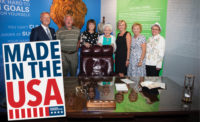When you’ve remained a successful business in an industry as competitive as roofing for 30 years, it’s safe to say that you’re doing it right. And when you’re chosen to re-roof a historic landmark in your company’s hometown, you’re doing it with purpose.
That’s exactly what Cram Roofing has been about since Gary Cram started the company in 1986. Now comprised of 110 non-union employees, the company continues to evolve while maintaining industry standards and exceeding customer expectations by providing exceptional service.
Though based in San Antonio, Cram installs and repairs all types of roofing systems across the United States. Some of their more well-known projects include the NASA Kennedy Space Center in Cape Canaveral, Fla. as well as several buildings at Camp Lejeune, located in Jacksonville, N.C.
None, however, carried the historical importance as their work on Texas’ signature landmark right in their backyard — the Alamo.
“When people from all over the world think of San Antonio one of the first things that comes to mind is the Alamo,” said Mark Eichelbaum, Cram’s vice president. “Being that we are from San Antonio, we were extremely proud to be trusted to work on such an iconic building that symbolizes our city.”
A Historical Statement
The Alamo Long Barrack was originally constructed as a two-story convent and served as the quarters and offices of the Spanish missionaries. During the 1836 Battle of the Alamo, the Long Barrack housed many members of the Alamo’s garrison, where they eventually went after Santa Anna’s soldiers.
The Alamo is deemed a State Antiquities Landmark and was designated a UNESCO World Heritage site in 2015. Today, the building serves as an exhibit space and auditorium that welcomes hundreds of visitors on any given day. As one of the most visited sites in Texas, the 5-acre historical landmark sees more than 2.5 million people each year.
Given the building’s age, along with daily visitor traffic, the Cram team faced several challenges in this unique re-roofing project. Limited access to the site meant that workers had to bring in materials daily before the grounds opened, and remove them at night once the grounds were closed.
Safety was also a major concern, as workers were unable to install anchors into the structure for tie-off points because of the age and condition of the structure. Cram used a fall-protection scaffold that encompassed the building’s exterior to ensure a safe jobsite.
Beyond staying safe, the focus was on maintaining the building’s historical integrity and original appearance while making the necessary renovations that would allow proper roof functionality for years to come. The roof had to provide shelter for the interior exhibits and proper drainage while upholding its historical elegance.
“Since this is such a historical building, the expectations for the finished project were very high,” said Kevin Blische, Cram Roofing’s estimating sales manager.
The Project
Following the roof’s failure that resulted in some structural damage, Cram Roofing replaced the Long Barrack roof in late summer/early fall of 2014 with a new, water-proof roof that will withstand the elements for many years to come. The 5,500 square-foot landmark took 10 weeks in total to complete on an accelerated timeline due to weather, ongoing events during the renovation and other needed repairs.
To start, they removed the roof to expose the wood beams supporting the structure. Following the replacement of these beams, a new SBS-modified bitumen roof was installed. Making sure to keep the historical significance of the building intact, the team carefully applied an adhesive as opposed to an open-flame tool that could have created a hazardous situation. Blische said that Cram was precise in taking all possible precautions to avoid damage to the structure, and that another primary objective was to keep as much of the building’s original appearance as possible.
When it came to the flashings used on the project, customization was the only option. Cram used PMMA liquid-applied flashings that were tailored to match the existing color.
The customization didn’t stop there. When replacing the original “canales” or drainage scuppers that filter the water off of the roof, Cram created a custom fabricated copper liner to protect the pieces from future erosion.
The Team
Cram Roofing specializes in the re-roofing process for both the commercial and municipal markets, and ensures quality workmanship through its set operating procedures put in place by management.
“The difference at Cram is the management team,” said Eichelbaum, a former CPA who changed careers on the cusp of fatherhood in 2002. He heard about Cram through a partner in the accounting firm he was working at and started out working on company finances before growing into his current role as vice president.
The management team at Cram is a big part of their approach to quality workmanship. In what are referred to as “handoff meetings,” Cram’s estimating department explains exactly what was sold on a particular job to the production team.
“It’s a process of getting everyone on the same page,” said Blische, who started with the company in 2009 after working as an inspector for a large metal roofing manufacturer.
Company officials also credit Cram’s success to a strong emphasis on building long-term customer relationships. A very important aspect of this is listening to the customer’s needs, and in turn, making it easy for them to conduct business with Cram. “If there is a specific item or aspect that they’re looking for, we want to fulfil those needs and maintain those high standards,” Blische explained.
Each department of Cram’s business works together successfully, keeping the focus centered on customer service and quality performance. Cram’s hiring process involves seeking out people that will help achieve these goals, and subsequently make the company stronger. Each employee is given the opportunity to use their strengths to fit each unique situation that may come up. As a team, they uncover solutions to problems with all members contributing thoughts and ideas, Eichelbaum said.
“My management philosophy is that I know what I’m good at and I know what I’m not good at, so I try and surround myself with people that have strengths in the areas that I’m not so good at,” he explained. “Together we can fill those voids.”
Cram does not subcontract work and employees are trained to install each roof using the specific tools unique to that type of job. Project managers are frequent visitors on jobsites, assuring that quality standards are being met. “The Cram Roofing team is a great group of people that work well together, which benefits the company and makes us more successful,” Blische said. Cram also works closely with manufacturers who make sure that the roofs are installed to their quality standards and fit the given warranty.
With a mission statement that includes providing a safe, positive and ethical work environment for its employees, Cram Roofing prides itself on following industry standards. The company is a part of the Roofing Contractors Association of Texas (RCAT), as well as many other local associations that help open the doors for future business development opportunities.
Blische said the company also takes great pride in knowing the custom repairs and maintenance completed at the Alamo will help safeguard the historic landmark’s future.
“It’s important to us that we give back to the community that has helped us become the company we are today and we feel we were able to do just that by preserving a piece of our city’s history,” he said.







